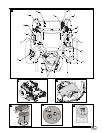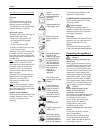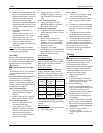
English Operating instructions
5
Risk of asphyxiation from carbon
monoxide
Run the IC engine outdoors only.
Risk of explosion and fire
Fuel/petrol vapours are explosive,
and fuel is highly flammable. Fill the
engine with fuel before turning the
ignition. Keep the petrol tank closed
when the engine is running or is still
hot. Refill with fuel only when the
engine has been switched OFF and has
cooled down. Avoid naked flames and
sparking, and do not smoke. Fuel the
appliance outdoors only. Do not start
the engine when fuel has overflowed.
Remove the appliance from the fuel-
contaminated site and wait until the
fuel has completely evaporated.
To prevent the risk of fire, please keep
the following parts free of grass and
leaking oil: engine, exhaust, battery,
fuel tank.
Risk of injury from defect
appliance
Operate the appliance only when it is
in perfect technical condition. Subject
the appliance every time to a visual
check before you operate it. Check for
any damage in particular on the safety
devices, the cutters and their mounts,
the controls, and the screw unions, and
make sure they all sit tightly. Replace
any damaged parts before operating
the appliance.
Operating hours
Observe the national and the
municipal regulations governing the
times the appliance may be used
(if necessary ask your local authority).
Before operating the appliance
Check the following:
• all guards
• the engine’s oil level (see engine
handbook)
• the fuel tank level
• the tyre pressure (see section
“Servicing”)
• side panels.
Also check add-on equipment and
the areas near air filters for soiling
and cuttings.
Adjustments before driving the
appliance
Caution!
Do not make any adjustments when
the engine is running or the
appliance is moving
• Park the appliance on a firm,
horizontal surface and engage
the locking brake.
• Perform all work when the engine
is switched OFF.
When working on moving parts:
• remove in addition the spark plug
terminal from the spark plug.
Adjusting the driver’s seat
Fig 20
• Loosen the two wing nuts (1).
• Push the seat (2) along the slide
rail (3) to the desired position.
• Retighten the wing nuts (1).
Adjusting the drive control levers
Fig 21
If necessary the drive control levers
can be adjusted higher or lower and
to the side.
Adjusting the height
• Remove the nuts (1).
• Remove the drive control lever
(3), but without removing the
screws (2).
• Use the screws (2) to secure the
drive control lever in the other
pair of holes (6) in the mount (4).
• Again fasten (tighten) the nuts
(1).
Adjusting the sides
• Loosen (do not remove) the nuts
(1).
• Move the drive control lever in
the adjusting segment (5)
backwards or forwards to the
desired position.
• Retighten the nuts (1).
Adjusting the cutter wheels
Fig 28
The cutter wheels should always be
6–12 mm above the ground at their
lowest cutter position. The cutter
wheels are not designed to bear the
weight of the cutters.
If necessary, arrange the wheels at
equal distances.
Starting the engine
Fig 10
• Sit on the driver’s seat.
• Place both drive control levers
into the outer Neutral recesses
(1 and 3).
• Turn the PTO switch (4) to OFF.
• Move up the cutters.
• Engage the locking brake.
• Do not
operate the drive control
levers.
• Move the accelerator lever (6)
to “Fast/ ”.
When the engine is cold, move
the accelerator lever to or pull
the choke (5) if your model
features this (a hot engine may
not need the choke).
• Turn the ignition key clockwise
to “Start/ ”. Once the engine
is running, release the key. It will
then return to ON/ .
Note! Do not keep the ignition key at
Start/ for longer than five seconds
per start attempt. Wait about one
minute before the next start attempt.
• Slowly press in the choke button
(if your appliance features this).
• Pull back on the accelerator lever
until the engine runs quietly.
Stopping the engine
• Turn the ignition key
anticlockwise to “O/ ”.
• Before leaving the appliance,
engage the locking brake and
withdraw the ignition key.
Driving the appliance
Caution!
Avoid abrupt engine starts, excessive
speed, and flat-out braking.
Be particularly careful when
reversing. Never change direction
(forwards to reverse and vice versa
or zero or pivot turns) without first
stopping the appliance. This appliance
has no turning circle; instead the rear
tyres serve as a pivot. A conventional
appliance can turn in a circle, but this
circle has a minimum diameter.
Owing to its short length and the
ability to turn about its own axis the
appliance exhibits superior
manoeuvrability.

















